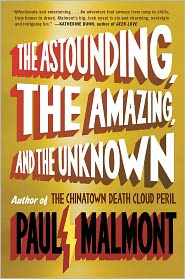By Paul Malmont
“The future begins in the imagination” (p. 24).
I knew going in that I would enjoy this novel, having last year devoured Malmont's earlier Chinatown Death Cloud Peril (which helped inspire this year's current obsession with pulp heroes). As much as I loved that earlier work, I think this one is even better. It's not necessary to have read Peril before AAU, but I think doing so will add to the reader's enjoyment because all of the main characters return, plus others.
In Peril, Malmont took the writers of the great hero pulps of the 1930s – mainly Walter Gibson (The Shadow), Lester Dent (Doc Savage), and L. Ron Hubbard (westerns) – on their own rousing pulp-style adventure. What began as an investigation into what turned out really to be the 1937 murder of horror writer H. P. Lovecraft ended up through various hair-raising adventures thwarting an international plot to supply poison gas to a Chinese warlord fighting against the Japanese.
The Astounding, the Amazing, and the Unknown takes place a few years later, in 1943, as the popularity of the hero pulps was waning against the backdrop both of World War II and the early rise of science fiction. The title, of course, is taken from the triumvirate of science-fiction pulps – Astounding Science Fiction (later Analog), Amazing Stories, and Unknown. It's well known (at least I knew it, since I long ago read Isaac Asimov's autobiography In Memory Yet Green) that several early science fiction writers who were also scientists were brought together during the war to work in scientific research at the Philadelphia Naval Yards. Along with Asimov there was L. Sprague de Camp and Robert Heinlein.
They are tasked with developing various fantastic weapons and defenses such as they have written about. Then the mysterious death of Nikola Tesla (turns out to be murder, of course) sends the group on a mission to rediscover a death-ray anti-aircraft defense that the genius had allegedly created long before. Hubbard – still basically a con man and opportunist but now in the navy albeit recently court-martialled for attacking Mexico on a wild-goose chase for a German U-boat only he ever saw – ends up along for the ride, as do Gibson and Dent. And more madcap, pulpish antics ensue! I'll leave off the summary with that – I don't want to spoil the story – but I will say that one of the major incidents around which this story revolves is the so-called “Philadelphia Experiment,” which we find out literally has more to do with magic than it does with science (he says cryptically). And looming in the background there is another, much more secretive scientific program under way – a little thing called the Manhattan Project.
 |
| Heinlein, de Camp, and Asimov |
Along with the main adventures, in addition to learning a lot about the orgins of science fiction literature, we learn a lot (sometimes more than we really want to know) about the personal lives of the early giants of science fiction and pulp. The wives of Asimov, Heinlein, de Camp, and Dent are major participants in the action. A whole slew of “minor” characters move in and out of the story as well – from Tesla at the beginning (indeed looming over all) to Hugo Gernsback and John W. Campbell, Jack Parsons, Forrest J. Ackerman, Norvell Page, Albert Einstein, and even Jimmy Stewart. It's all framed, interestingly, as Richard Feynman at the beginning of the book telling Robert J. Oppenheimer a story he hears from L. Ron Hubbard at the end of the book.
Like we did for Gibson and Dent in Peril, here in AAU we get insight into the personalities of the writers, most notably Asimov and Heinlein. In the case of the former his emotionally stunted nerdishness, in the case of the latter his disappointment at having been forced out of active duty as a military officer by tuberculosis and his longing to break out into more prestigious publication – even real books, the holy grail of the pulp writers. Hubbard continues to be a charming rogue, impossible to really dislike even knowing that his fundamental nature as a con man is within just a few years going to give birth to his biggest con of all, the creation of his own new religion. We actually see the germination of that development in discussions of the role of science fiction – science itself as a new faith. Along with such discussion of the nature of science fiction a recurring theme of this book is, as maybe best expressed in the quotation with which I opened this blog entry, the intersection of science fiction and scientific advancement in the wonders of the human imagination.
It's great stuff! Cheers!


No comments:
Post a Comment